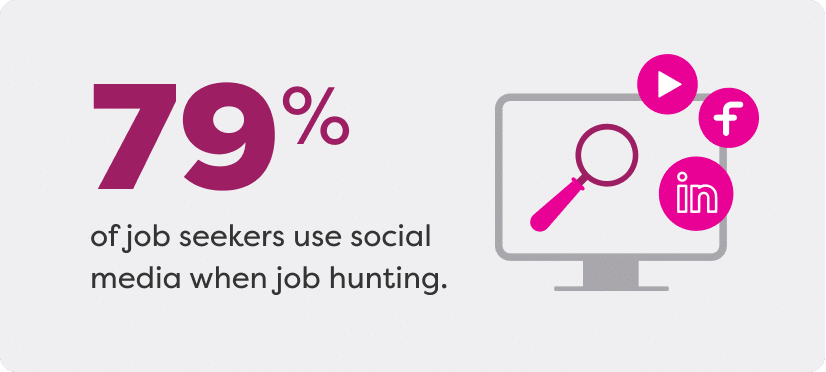Over the past few years, HR marketing has evolved considerably to adapt to job market changes and candidates’ new expectations. Recruiters and HR departments have had to revolutionize their practices to meet new challenges and keep up with the competition.
What can we expect in 2025 and beyond? We’ll tell you more about today’s recruitment challenges and the key trends you need to consider when implementing an effective HR marketing strategy!
What Is HR Marketing?
HR marketing covers all the efforts and strategies a company uses to promote its employer brand and improve its corporate culture, aiming to attract, engage, and retain the best talent.
HR marketing aims to build a solid employer reputation and solidify organizational culture to attract potential candidates, whether they are actively seeking employment or not. This strategy helps avoid difficulties in filling vacancies and finding qualified candidates whose personality aligns with the organization’s values. It also aims to improve retention rates for new hires and enhance their overall employee experience.
Current Recruitment Challenges
Any HR marketing strategy requires a thorough understanding of today’s job market and the associated recruitment challenges.
Today’s environment is more complex than ever. 2022 was a record year for job vacancies, during which organizations across all sectors struggled to recruit qualified candidates. Today, we are witnessing mass layoffs.
The post-pandemic economic situation and the emergence of artificial intelligence are just some of the reasons why companies are recruiting less. Workers are also faced with inflation and growing social and political tensions, creating an unprecedented climate of anxiety and uncertainty. The result? Unmotivated and less productive employees who fear for their job security and professional future.
But will this problematic economic situation persist for companies and workers? Will the “power balance” between recruiters and candidates shift in favor of employers? The reality is more complex than that.
But will this difficult economic situation persist for companies and workers? Will the “balance of power” between recruiters and candidates shift in favor of employers? The reality is more complicated.
Indeed, studies estimate that by 2030, after challenging transitions, we should be able to create enough jobs to reach full employment. This could mean that a new “talent war” is on the horizon, and recruiters need to be aware of the trends they must consider in their HR marketing strategy to prepare for this situation.
Key HR Marketing Trends in 2025
Here are the HR marketing trends and issues you need to focus on in 2025 – but also to prepare for the future world of recruitment!
1. Recruit less, but recruit better
In today’s recruitment market, fewer recruits are being taken on, and selection processes are more demanding than a few years ago. Employers are therefore favoring quantity over quality, receiving more applications for each open position, while competition between candidates is intensifying.
This trend impacts your HR marketing strategy, as the goal is no longer to get the most applications but to attract the best talent. To do this, you need to write job postings detailing the skills and qualities you’re looking for and what sets your organization apart from others.
Benefits, a healthy work environment, attractive salaries and flexibility are your best allies when trying to attract qualified candidates. Moreover, a rigorous and transparent selection process (based on healthy communication with assessed candidates at every stage and marked by thoughtful but swift decision-making) will strengthen your chances of hiring the best fit. Finally, keeping an eye on recruitment statistics is a good practice for anticipating potential changes and challenges.
2. Adapting to emerging jobs
The emergence of new technologies and artificial intelligence is leading to the creation of a wide variety of little-known jobs. Recruiters, therefore, need to learn about the skills and profiles associated with these new types of jobs to stay one step ahead. By demonstrating their expertise and knowledge of the technological environment, employers and recruiters can attract talent in this field and keep up with the competition. Using effective automation tools like LinkedHelper can be a great way to be efficient at all times.
Knowing the expectations of these new profiles and focusing on fulfilling them in your job offers, recruitment processes, and employee experience is also essential to your success.
3. Prioritize employer branding on social networks
Social networks are playing an increasingly important role in enhancing your employer brand. Statistics show that 85% of jobseekers under 40 check a company’s reputation (employee reviews, social media) before applying for a vacancy.
So, how can you stand out from the crowd?
Your best asset is your employees and their ability to become ambassadors for your employer brand. To benefit from employee ambassadors, you need to build a corporate culture and employer brand that goes beyond words and puts real actions in place. An award-winning marketing team can help showcase these authentic stories effectively, ensuring that your employer brand resonates with potential candidates across social platforms.
Be authentic in your values, work environment and the benefits you offer your teams, and your reputation will grow organically on social networks.
Use your brand awareness to promote your culture to candidates by creating videos, photos and posts highlighting your employees and their daily lives within the organization.

4. Focus on employee benefits and recognition
To implement a relevant and effective HR marketing strategy, you need to understand the expectations of new generations of workers. Here are their priorities, as revealed by a survey of over 10,000 graduating students:
- Quality employee benefits: beyond salary expectations, it’s employee benefits programs that most attract job seekers. The unstable economic context and the prioritization of mental and physical health lead candidates to favor companies that offer quality benefits and health insurance.
- Recognition: while all employees appreciate words of recognition, they also expect more concrete signs of appreciation, such as rewards and salary increases.
- Healthy professional relationships: beyond respectful professional exchanges, workers are now looking for relationships that are less marked by the hierarchical system. They want to play a more decisive and creative role, to be an integral part of an organizational mission in which they see themselves reflected.
As for flexibility, it has become a norm in many organizations and is a no-brainer for job seekers, who now focus on truly differentiating advantages. To stand out from the crowd, you need to go beyond remote and hybrid work possibilities!
5. Rely on surveys and HR KPIs
The best way to ensure that you offer a positive candidate experience is to survey new hires when they join your company. You can also ask unsuccessful candidates what they thought of your recruitment processes. Their feedback will help you identify areas for improvement and optimize your practices.
HR KPIs are also valuable allies in evaluating your recruitment processes: they enable you to visualize your recruitment costs, the average time to fill your positions, and much more. Tracking and analyzing them gives you essential strategic insights for improving your HR marketing.
6. Use technology to modernize your practices
Here are a few tools to invest in if you want to modernize your HR strategies and HR marketing efforts:
- ATS (Applicant Tracking System): these solutions help provide quick responses and personalized communications to candidates. They allow you to find the best talent in just a few clicks, thanks to keyword searches.
- HR reporting software with dashboard and KPI features: these functions are often included in HR software and enable you to see at a glance the efficiency of your recruitment processes (costs, time, offer acceptance rates) to help you optimize your HR marketing strategies.
- Artificial intelligence tools: AI is already impacting the way we recruit people. Among other things, AI features enable you to personalize all your hiring and onboarding processes to deliver a better candidate experience.
Whichever tool you choose, the key is to continuously rethink and optimize your recruitment practices and maintain positive relationships with candidates from start to finish.
With the growing importance of employer branding and reputation on social networks, the emergence of artificial intelligence and new issues arising in the job market, the next few years are shaping up to be turbulent for recruitment and HR marketing. To meet all these challenges and ensure effective hiring, implement a powerful ATS adapted to your reality!
Improve your HR marketing with the right recruitment tools:
Choose the best ATS for Canadian SMBs!

